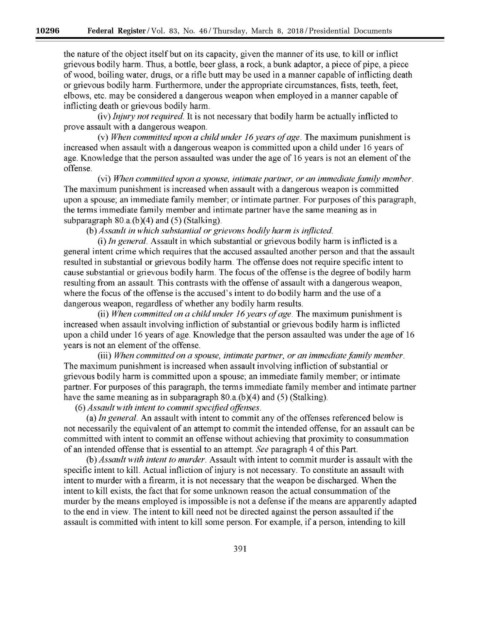Page 593 - Trump Executive Orders 2017-2021
P. 593
10296 Federal Register / Vol. 83, No. 46 / Thursday, March 8, 2018 / Presidential Documents
the nature of the object itself but on its capacity, given the manner of its use, to kill or inflict
grievous bodily hann. Thus, a bottle, beer glass, a rock, a bunk adaptor, a piece of pipe, a piece
of wood, boiling water, drugs, or a rifle butt may be used in a manner capable of inflicting death
or grievous bodily harm. Furthennore, under the appropriate circumstances, fists, teeth, feet,
elbows, etc. may be considered a dangerous weapon when employed in a manner capable of
inflicting death or grievous bodily harm.
(iv) il?jwy not required. It is not necessary that bodily harm be actually inflicted to
prove assault with a dangerous weapon.
(v) When committed upon a child under 16 years of age. The maximum punishment is
increased when assault with a dangerous weapon is committed upon a child under 16 years of
age. Knowledge that the person assaulted was under the age of 16 years is not an element of the
offense.
(vi) When committed upon a .~pouse, intimate partner, or an immediate family member.
The maximum punishment is increased when assault with a dangerous weapon is committed
upon a spouse; an immediate family member; or intimate partner. For purposes of this paragraph,
the terms immediate family member and intimate partner have the same meaning as in
subparagraph 80.a.(b )(4) and (5) (Stalking).
(b) Assault in which substantial or grievous bodily harm is it?flicted.
(i) In general. Assault in which substantial or grievous bodily harm is inflicted is a
general intent crime which requires that the accused assaulted another person and that the assault
resulted in substantial or grievous bodily harm. The offense does not require specific intent to
cause substantial or grievous bodily harm. The focus of the offense is the degree ofbodily harm
resulting from an assault. This contrasts with the offense of assault with a dangerous weapon,
where the focus of the offense is the accused's intent to do bodily harm and the use of a
dangerous weapon, regardless of whether any bodily harm results.
(ii) When committed on a child under 16 years of age. The maximum punishment is
increased when assault involving infliction of substantial or grievous bodily harm is inflicted
upon a child under 16 years of age. Knowledge that the person assaulted was under the age of 16
years is not an element of the offense.
(iii) When committed on a spouse, intimate partner, or an immediate family member.
The maximum punishment is increased when assault involving infliction of substantial or
grievous bodily hann is committed upon a spouse; an immediate family member; or intimate
partner. For purposes of this paragraph, the tem1s immediate family member and intimate partner
have the same meaning as in subparagraph 80.a.(b)(4) and (5) (Stalking).
(6) Assault with intent to commit specified ojjimses.
(a) In general. An assault with intent to commit any of the offenses referenced below is
not necessarily the equivalent of an attempt to commit the intended offense, for an assault can be
committed with intent to commit an offense without achieving that proximity to consummation
of an intended offense that is essential to an attempt. See paragraph 4 of this Part.
(b) Assault with intent to murder. Assault with intent to commit murder is assault with the
specific intent to kill. Actual infliction ofinjmy is not necessary. To constitute an assault with
intent to murder with a firearm, it is not necessary that the weapon be discharged. When the
intent to kill exists, the fact that for some unknown reason the actual consummation of the
murder by the means employed is impossible is not a defense if the means are apparently adapted
to the end in view. The intent to kill need not be directed against the person assaulted if the
sradovich on DSK3GMQ082PROD with PRES DOCS VerDate Sep<11>2014 18:39 Mar 07, 2018 Jkt 244001 PO 00000 Frm 00410 Fmt 4705 Sfmt 4790 E:\FR\FM\08MRE0.SGM 08MRE0 ER08MR18.412</GPH>
assault is committed with intent to kill some person. For example, if a person, intending to kill
391

